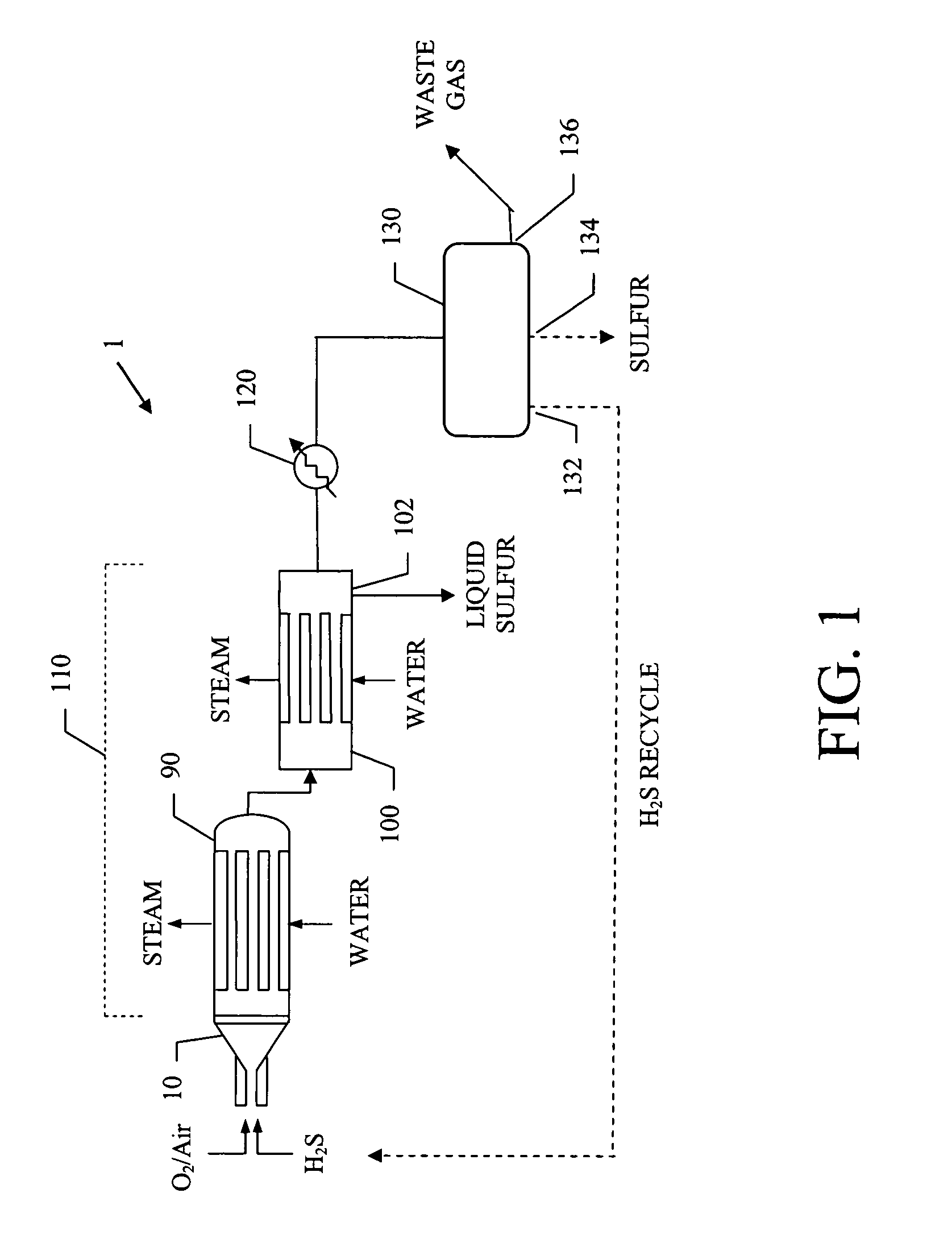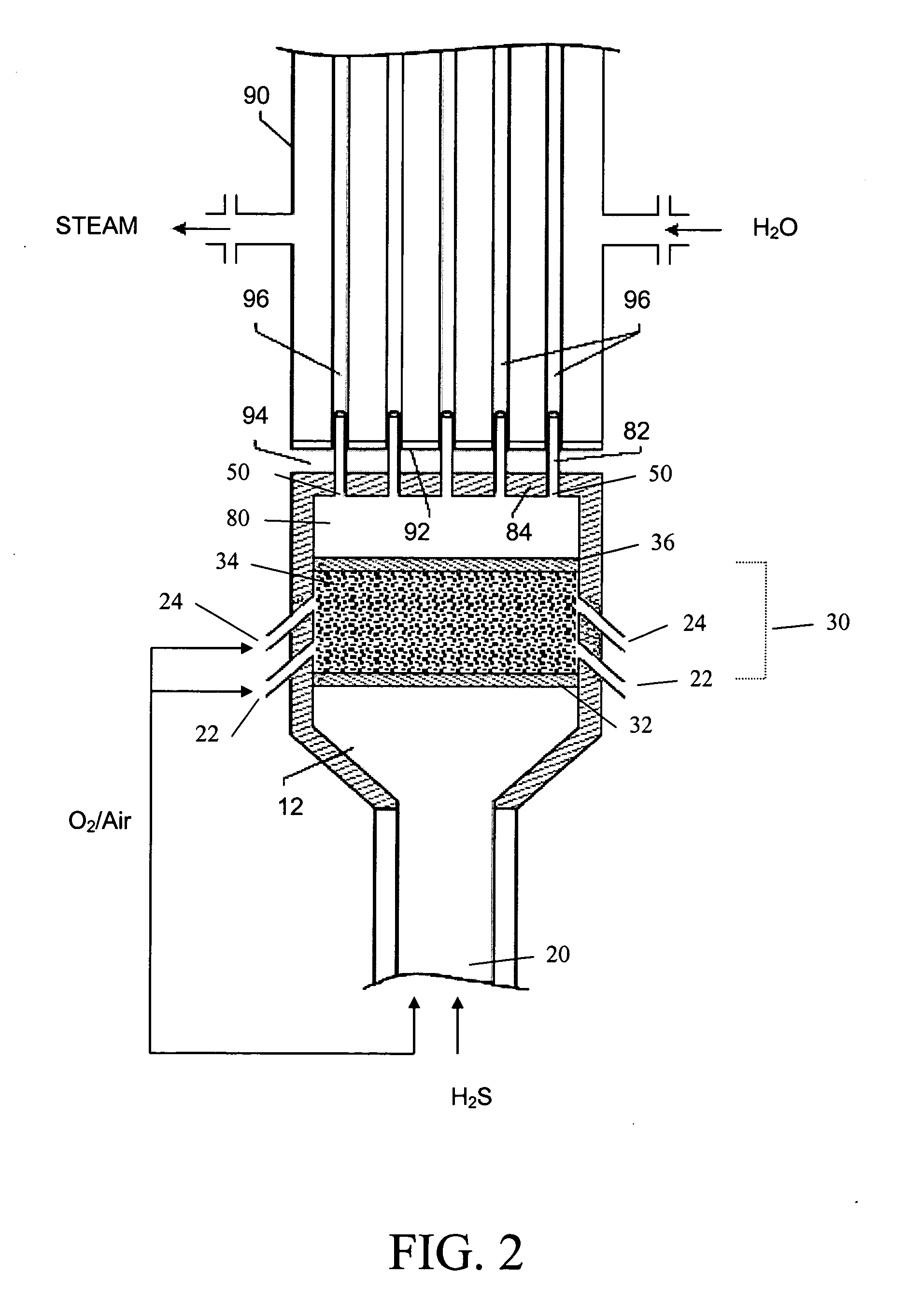Process for the catalytic partial oxidation of H2S using staged addition of oxygen
a technology of partial oxidation and h2s, which is applied in the direction of sulfur compounds, physical/chemical process catalysts, sulfur preparation/purification, etc., can solve the problems of reducing the efficiency of sulfur removal plants, reducing the market value of gas, so as to reduce pollution of the air, reduce pollution, and reduce the effect of sulfur removal
- Summary
- Abstract
- Description
- Claims
- Application Information
AI Technical Summary
Benefits of technology
Problems solved by technology
Method used
Image
Examples
example 1
[0077] A catalyst having the composition 1% Rh, 4% Pt, 3% Mg on fused alpha-alumina pills, 4 grams was prepared and tested as described above. The H2S flow rate was 850 ml / min, or 0.85 SLPM, and the reactant gas preheat temperature was 450° F. (232° C.). The results of those tests are shown in Table 3.
TABLE 3Effect of Air / H2S Ratio on H2S Conversionand Product SelectivityAir / H2S% H2S% Sulfur% SO2% H2% S0% SO2RatioConversionYieldYieldYieldSelectivitySelectivity2.3784.4872.7911.666.6586.1613.802.2683.7673.1710.556.4087.3612.602.1682.7773.659.096.4688.9810.982.0781.6473.757.866.5690.339.631.9779.9773.206.746.6691.538.421.8785.6182.093.504.2995.894.091.7776.2571.614.606.7893.926.041.6774.4570.713.716.9594.984.981.5772.1169.083.016.9595.794.17
Catalyst: 1% Rh, 4% Pt, 3% Mg on fused alpha-alumina pills
example 2
[0078] A catalyst having the composition 1% Rh, 4% Pt, 3% Mg on fused alpha-alumina pills, 4 grams was prepared and tested as described above. The H2S flow rate was 950 ml / min, or 0.95 SLPM, and the reactant gas preheat temperature was 450° F. (232° C.). The results of those tests are shown in Table 4.
TABLE 4Effect of Air / H2S Ratio on H2S Conversionand Product SelectivityAir / H2S% H2S% Sulfur% SO2% H2% S0% SO2RatioConversionYieldYieldYieldSelectivitySelectivity2.7685.7566.3119.417.8077.3322.642.6685.1167.1717.917.9778.9321.042.5584.3968.0516.318.1580.6419.332.4683.5168.6414.878.3982.1917.812.3681.5967.5014.089.0082.7417.262.2581.3069.1812.108.8985.0914.882.1780.1069.3110.779.0086.5213.452.0678.8769.459.408.9188.0511.921.9777.0968.868.218.7189.3210.651.8774.8367.996.828.1790.869.111.7772.2266.395.817.4191.928.051.6769.0263.995.016.4692.717.261.5765.2860.914.355.3793.306.661.4761.2457.383.844.2293.706.261.3757.7954.303.473.1193.966.001.2754.4250.963.452.2193.636.33
Catalyst: 1% Rh, 4%...
example 3
[0079] A catalyst having the composition 4% Pt, 1% Rh, 3% Mg on MgO granules, 4 grams, was prepared and tested as described above. The H2S flow rate was 1,050 ml / min, or 1.05 SLPM, and the reactant gas preheat temperature was 450° F. (232° C.). The results of those tests are shown in Table 5.
TABLE 5Effect of Air / H2S Ratio on H2S Conversionand Product SelectivityAir / H2S% H2S% Sulfur% SO2% H2% S0% SO2RatioConversionYieldYieldYieldSelectivitySelectivity2.3784.6173.8010.814.8187.2212.782.2783.9873.7710.186.3087.8512.122.1782.4173.269.136.5888.8911.082.0780.9472.937.996.6190.119.871.9779.1672.376.766.6191.438.541.7775.7470.725.016.3493.366.611.5771.5968.283.296.1595.374.601.4868.3565.792.536.2396.263.701.3865.6763.642.006.1696.913.05
Catalyst: 4% Pt, 1% Rh, 3% Mg on MgO granules
PUM
| Property | Measurement | Unit |
|---|---|---|
| Temperature | aaaaa | aaaaa |
| Temperature | aaaaa | aaaaa |
| Temperature | aaaaa | aaaaa |
Abstract
Description
Claims
Application Information
 Login to View More
Login to View More - R&D
- Intellectual Property
- Life Sciences
- Materials
- Tech Scout
- Unparalleled Data Quality
- Higher Quality Content
- 60% Fewer Hallucinations
Browse by: Latest US Patents, China's latest patents, Technical Efficacy Thesaurus, Application Domain, Technology Topic, Popular Technical Reports.
© 2025 PatSnap. All rights reserved.Legal|Privacy policy|Modern Slavery Act Transparency Statement|Sitemap|About US| Contact US: help@patsnap.com



